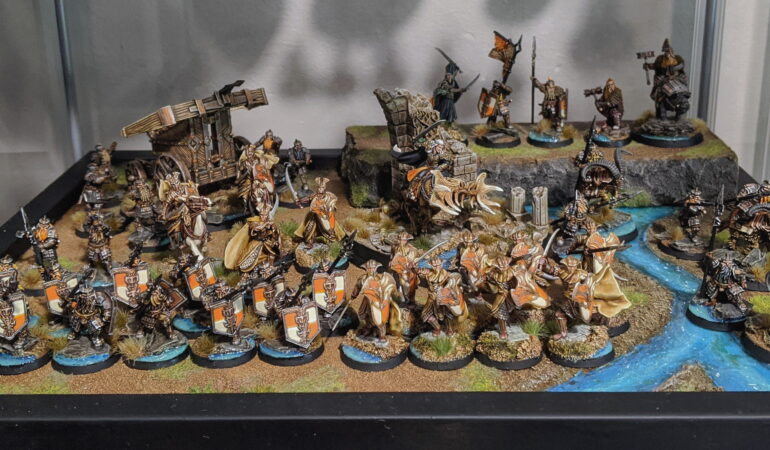
2019 – what a time. Back when the concept of a ‘lockdown’ or ‘social distancing’ had yet to enter my consideration, when the idea of working from home for 6 months was unimaginable. Back when miniature wargaming events were still regular and well attended. Good lord, I miss 2019.
Of all the many terrific events that I attended in 2019, the highlight of the year was the Scouring of Stirlingshire in November. One of the largest events in the UK Middle-earth SBG calendar, 60 players from all over the country (and even further afield) arrived with 800 points of both Good and Evil. It’s an awesome event, with a ton of beautifully furnished tabletops to play on and a great mix of local regulars and new faces. But by far the most exciting part of the event, for me, is the format.
I’ve said it before, but one of the most exciting aspects of Middle-earth SBG to me has always been this idea that it’s designed to be played as a Good vs Evil game, and that players are generally encouraged to collect both a Good and an Evil army. This isn’t the most accessible of notions however and – perhaps understandably – isn’t really enforced in Matched Play. Most tournaments/events only require a player to bring one army, and the rules allow for one player to be the ‘designated’ Good or Evil in same faction matchups. So, when an event – particularly a venerable, well attended event such as Scouring of Stirlingshire – requires players bring and field both a Good and an Evil army – I find this extremely exciting.
There’s a number of reasons that bringing both a Good and an Evil army is so exciting. Some of it’s variety – your mileage may vary, but in my experience, the majority of players of Middle-earth tend to prefer to play Good armies over Evil, so facing and fielding both factions equally helps add a little variety to the experience. Some of it is theme – Middle-earth is just so much more fun when you’re fielding Riders of Rohan against the forces of Isenguard, rather than Hobbits of the Shire. There’s also a lot to be said about how the rules interact with each other – Evil typically having worse Courage means your Good units that cause Terror will be more effective, and vice versa for Evil. It changes the dynamics of things a little bit.
Of course, the main reason I enjoy fielding both armies is more to do with the hobby side of things. You don’t typically see a lot of drab, dingy looking armies wining Best Painted awards on their own – people are naturally more attracted to brighter, more colourful armies – so it’s kind of exciting to see these armies to get their time in the sun. As everybody brings both a Good and an Evil army, everyone’s kind of on an even footing as it were – which is really, really cool.
Another cool benefit of bringing both a Good and an Evil army is the massive potential for playing with theme. At last years Scouring of Stirlingshire, I didn’t really do all that much in the way of theme. I brought my Rivendell Elves and Angmar – not entirely unrelated armies, but not quite as thematic as, say, Rivendell and Barad-dûr or Angmar and Arnor. For this year1, I aimed for things to be a little different.
This year, I’d finally finished the big box of Azog’s Legion that I’d been coveting for a pretty unreasonable amount of time. I’m pretty dang proud of them, so they were my natural pick for Scouring 2020. My Iron Hills – an army thus far fielded only once at events so far (at One Last Adventure 2019) – were a perfect pick of companion army. The only downside being that I had only 600 or so points worth of models.
I thought long and hard about expanding my Iron Hills up to 800 points (or larger). The Iron Hills Chariot is a pretty impressive looking miniature, and would make a nice little centrepiece (and good 2nd hero option after Dain). Throw that in the list with a few Crossbowmen for good measure and job’s a good ‘un. I was pretty dead set on the idea – and to be honest, I may yet return and revisit it – but somewhere along the line I got this idea in my head that it would be cool to put Thranduil in the list alongside Dain. I could add in a couple of Mirkwood Cavalry and some Palace Guard and make a whole thing of it. Thranduil is an awesome model and a great centrepiece in his own right, and the Elves help add a little visual variety to the army. I could use the same orange and ivory heraldry of my Iron Hills on the Mirkwood miniatures to unify the whole army and keep things looking completely consistent. To tell the truth, I wasn’t entirely sure if this was actually a brilliant idea, or if I just really wanted to paint that Thranduil on Elk miniature. Now that’s it’s finished, I’m still not really 100%, but here we are.
As is my way, I started with the Infantry.
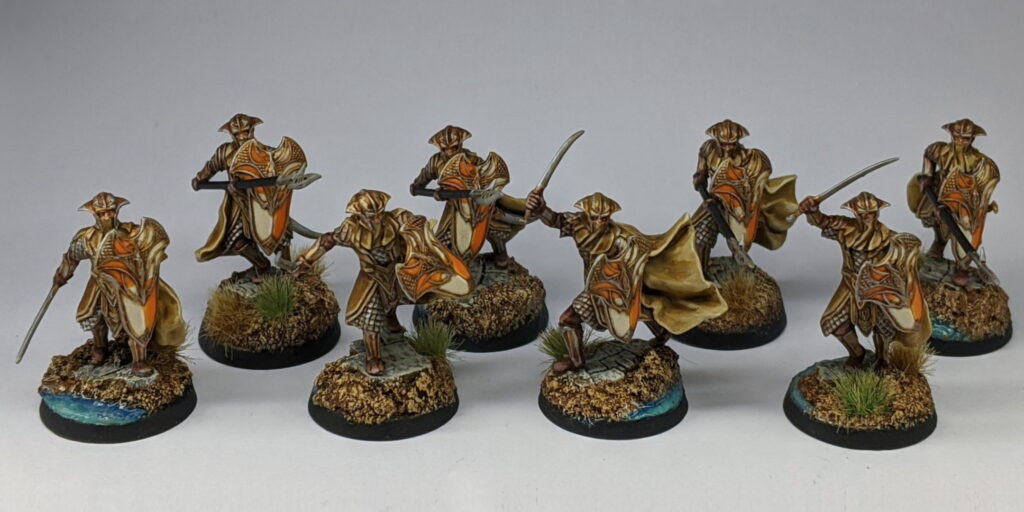
Boy, do I have things to say about these miniatures. It’s always a bit of a weird experience building these Hobbit-era plastics – you can really tell that Games Workshop were in a period of change. Finecast was still being produced fairly regularly at this point and although the quality of their plastic miniatures was rapidly catching up what you could achieve with Finecast, it still wasn’t quite as sharp as or detailed as the plastic minis produced today. Assemble a Palace Guard next to a Mirkwood Armoured Elf and you’ll see a number of little details – the plastics have somewhat softer details than the Finecast, and there’s seemingly a ceiling on how fine or delicate any one detail can get. The shields are an interesting point of comparison – two (pretty much) identical designs, only really distinguished by the medium. The Finecast shields have somewhat sharper scales and a deeper recess around the trim that make them slightly easier to paint than their plastic counterparts, although not once did I find myself having to carefully repair said trim with a little green stuff where it from damage sustained before even taking the miniature out of the box like I did on the Finecast shields. It’s just an interesting period, where the differences in medium had never quite been so close – and yet still produced such drastically different miniatures.
The plastic Palace Guard kit itself is kind of odd. Putting aside the bizarre choice to make the humble battle line Mirkwood Warrior in Finecast while the more elite and likely far less numerous Royal Guard and Rangers miniatures enjoyed a plastic kit, said plastic kit is.. probably less optimal than you might hope. With a whopping 20 minis in the box, you might be inclined to think “hey, great, that’ll give me loads of options for poses!” Well, think again.
Before I go on, some of the issues I complain about here are not really issues with this kit. For example, every Palace Guard miniature is modelled with a scabard – in the case of the sword and shield guys, the sword is not in the scabard (because it’s in their hand). This is a nice little out of the box touch, but it does make life prohibitively difficult for anyone like me who was hoping to put swap some arms around on the duplicated sprue to create more unique poses. No chance of putting a set of sword and shield arms on the spearmen here. Additionally, every miniature in the box can be assembled with or without a shield. That’s.. kind of a positive, right? You get complete versatility on who you give a shield to. Want a bunch of cheap sword-only equipped Palace Guard? You can do that. The downside, however, is that the kit only comes with only 12 Shields, so if you were hoping to put Shields on everyone, then functionally it only really builds 12 models. Another downside is that it is a pain in the ass to get those shields attached firmly – there’s no handle modelled on there to go around the fist, and no clear attachment point on either the sword or spear armed models. You need to do a bit of experimenting to figure out where the best place to put a shield on most of the models really is. Like I said, these aren’t issues with the kit, per se. They could even be argued to be features, but I found them annoying none the less.
Before we move on from the topic of building and onto painting, now is probably as good a time as any to mention the bases on these models. I wanted my Mirkwood miniatures to fit in with the Iron Hills – they’re built to be functionally the same army, after all. Still, I wanted them to have their own personality – to fit together, but also to feel separate. I also didn’t want to waste the awesome 3 part scenic display base that came with Thranduil, so I needed something that wouldn’t look jarring next to both the cobbled ruins on Thranduil’s scenic base and the rocky hilltops of the Iron Hills. After a lot of shopping around, I stumbled upon this Mystic basing kit from Micro Art Studios. That kit mostly features rubble surrounding paved ruins, with ‘mystic’ decorative flair in places. I bought a couple of kits, and used my clippers to cut off any areas with the metallic ‘mystic’ decoration, leaving just bits and pieces of paved rubble. These were CA glued down to my miniatures’ bases and surrounded with some sand/debris to level out the base and hide any rough edges where I cut the resin – with just a little flat space left for a little water effect to go. Finally, I smooshed a little Vallejo Earth Texture into any areas that looked a little too uneven and called it finished. I painted these in the same light brown of my other bases, with a flash of grey and a little bright blue for the water. I think that overall, do they the job well of fitting in with both Thranduil and my Iron Hills.
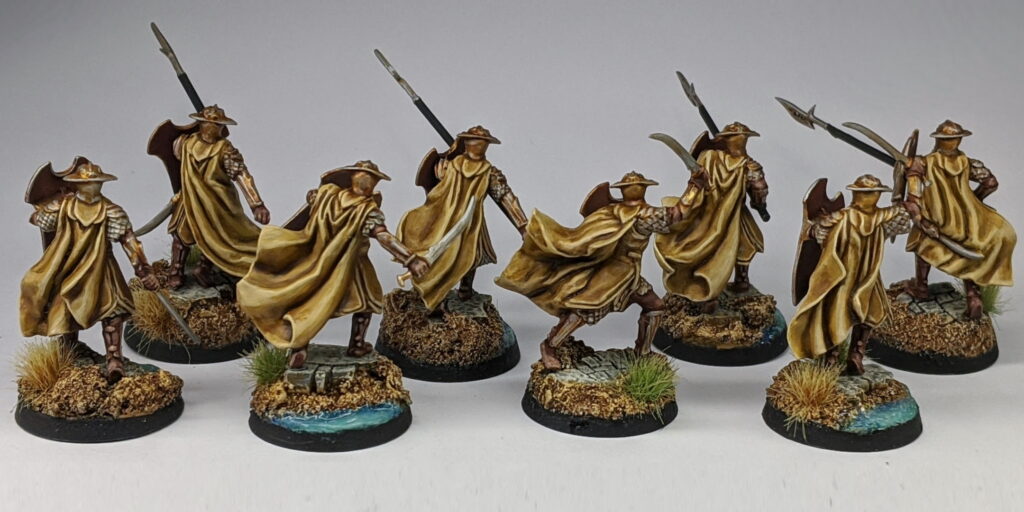
I quite enjoyed painting these Royal Guard. It was an interesting challenge to approach painting these Elves similarly to my Iron Hills, rather than trying to emulate my Rivendell Elves. The temptation was to paint these miniatures in bright, saturated tones – particularly with the big, billowing capes on every miniature – but I wanted to keep things on theme here and match them aesthetically to my Iron Hills. This wasn’t exactly hard to envision, as they appear fairly subdued in Games Workshop’s own marketing materials – nice warm ivory cloaks enrobing leathers and nice lavish Gold-ish armours, with just a flash of silver on the scale mail and weapons.
Technically speaking, much of the miniature was tackled in the same way that I painted my Iron Hills – black polearms, Dark Fleshtone for the boots and heavy leathers, and Leather Brown for the jerkins and tunics. All painted in my usual go to method of basecoat, wash, layer, highlight, wash again, highlight. The golden armour was basecoated in Vallejo Game Glorious Gold, edge highlighted with Army Painter Shining Silver, washed with Seraphim Sepia and highlighted again with Shining Silver. The shields were done in the same Firey Orange/Elfic Fleshtone quartered scheme as the before, though I will say that painting these shields was a lot more fiddley than the ones on the Dwarves, thanks to the delicate metallic trim and the tiny little embossed sections on the upper half of the shield.
While I normally like to wash/glaze my Elven Blades with just a little bit of Guilliman Glaze, I decided to hold off on the colour this time and simply used Seraphim Sepia like the rest of the metals. Seraphim Sepia isn’t a shade that I use often for silver, but it does give it a nice, warm appearance without the griminess of Agrax Earthshade or the cold, oily black of Nuln Oil. Looking back on it, a feint green tinge might have been a nice callback to my Rivendell Elves while still keeping to the armies overall aesthetics2, but I’m happy with my choice of a more practical, rustic earth tone for these (arguably) least heroic Elves of Middle-earth. I might keep the green Elven Blades idea in my back pocket for if I ever do any Galadhrim down the line.
For those billowing ivory cloaks, I decided to break out a new paint that I’ve had sitting unopened on my rack for some time now – Vallejo Game Desert Yellow. It’s not far off VG Khaki, though a little bit warmer and yellowish. As I was starting to run low out on unique earth tones for these miniatures, this new addition really saved the day. The cloaks were painted from a Dessert Yellow basecoat and highlighted with a Dessert Yellow/Elfic Flesh mix, followed by a shade of Seraphim Sepia. I then repeated this process again, pushing the Elfic Flesh a little brighter and washing with Seraphim Sepia dilluted with a little Lahmian Medium to help blend the layers a little better.
And that’s all there really is to say about the Palace Guard. I painted the cobbled stones on their bases a slightly lighter shade of grey than the muddy rocks of the Iron Hills, and threw introduced some Army Painter Swamp Tuft onto a few of the bases for just a splash of extra colour (they are ‘Wood Elves’ after all).
With the infantry were out of the way, out came my real reason for playing Mirkwood – Thranduil on Elk.
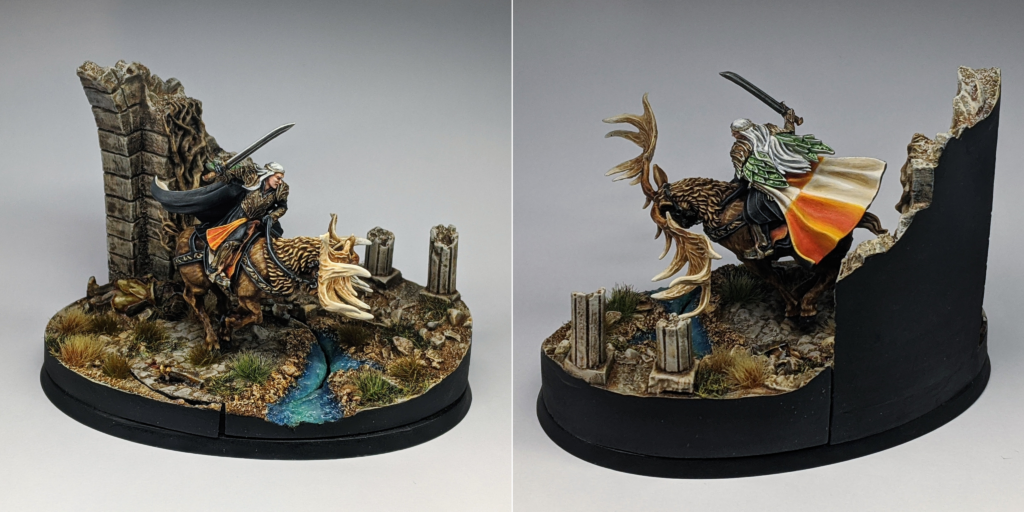
What a miniature this one is. I’m not always the biggest fan of ForgeWorld’s scenic bases for their Character Series miniatures; I find basing to be one of the least stressful, most creative and enjoyable parts of miniature painting, so having that enjoyable, crafty process replaced with another highly detailed sculpt to paint isn’t always worth the added cost to the miniature in my eyes. That beings said, sometimes ForgeWorld just really knock it out of the park – and I think that this is the case for Thranduil, King of Mirkwood. The delicately cobbled ruins and intricate creeping branch over the shattered archway are lovely features, while the prevalent dirt and debris scattered across the base is a nice, generic feature that can be used to help blend this base in with the rest of your army. What really gets me though is that lovely smooth, curved finish behind the base – it’s a classy feature for a display piece, and something that I’m not convinced I could pull off myself on a scratch build. Really, the only thing I can fault with the display base was how difficult I found it to track down appropriate basing material to help match the rest of the army to this scenic base. I’m pretty happy with what I achieved in the end, but it would’ve been nice to find a closer match somewhere. Even now, a part of me thinks I would rip the bases off these models and start again if I found a closer match.
Beyond the base, the miniature itself beautiful, and stylistically in keeping with ForgeWorld’s aesthetic on the Iron Hills range. The rich, billowing cloak, pronounced scale mail and delicate filigree on the harnesses are nice little details that accentuate a dynamic pose and excellent likeness of Lee Pace’s Thranduil. Even the dreaded banana fur that ForgeWorld are responsible for from time to time seems more at home here than it did on ForgeWorld’s much maligned Varagyr miniatures.
I’d like to say the build was uneventful, but one extremely irritating issue with this miniature being cast in resin was that both the sword (which, in fairness, looks considerably nicer than the one on GW’s finecast Thranduil) and the ankles of the Elk were extremely flimsy and were snapped during either construction or the early stages of painting. As the contact points were so narrow themselves, the usual paperclip pin method wasn’t going to fly here. In the end, I had to (very carefully) drill out a very fine hole on either side of the break using a 0.5mm drill piece3 in my pin vice and pin the joint with a little piece of wire that I liberated from one of those little rubber-coated wire cable ties that come often come twisted around a new USB cable. Guitar string would also work just as well here, and you could even match the gauge of the string to your drill bit if you were being really precise.
I didn’t do much to the miniature in the way of converting, though I did think that this model was going to stick out like a sore thumb in my army if it didn’t have any water effect on the base. To that end, I cut off the front of Thranduil’s little scenic base puck, sanded down the top edge and roughed up the newly smooth surface with a light dusting of sand and debris. I lined up the minature in it’s the display base and then drew the outline of a little stream such that Thranduil’s little water feature would line up nicely within it. Carving out the little stream was a little bit harder, as I couldn’t just clip the whole thing away – I had to slowly carve away at it with a pair of old clippers and my x-acto knife until the water indent went as deep as Thranduil’s little base water feature. As with on the miniature, I covered up the areas I cut into with a little sand and debris, which blended in quite nicely with the debris on the base itself once it was all primed.
The display base itself was a doddle to paint. Grey stone, leather brown dirt, Heavy Brown branch. Elfic Flesh drybrush, Seraphim Sepia wash – then a little Nihilakh Oxide and Guilliman Blue in the stream to finish it off. Pretty much that simple, although I may have done a second wash/drybrush pass in a few areas. The dead Orc on the base I painted to match my Azog’s Legion, and I even applied a tiny bit of Blood for the Blood God spilling out of the decapitated head – although I mixed this with a bit of Nuln Oil to tone down the colour and shine; I don’t like to call too much attention to gore on my Good miniatures.
So, that’s the scenic base. What about the miniature itself?
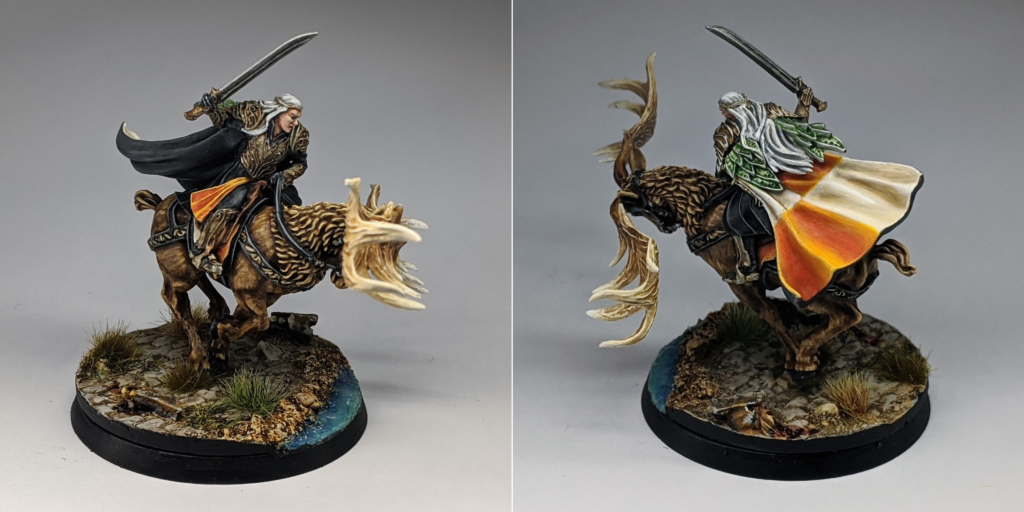
Well, there’s a whole lot of stuff to cover here so let’s rattle through it as quick as we can.
The Elk was given a kind of textured effect to represent the fur, painted by building up layers of highlights in tiny little lines, toned down and blended together somewhat with a wash of Seraphim Sepia, then built up some more. The main colours I used here were Beasty Brown, Leather Brown and Elfic Flesh to lighten up the layers. After a few (at least) 5 passes, you get a reasonably fine looking ‘fur’ effect that makes the elk look a little, erm.. furrier I suppose, than your garden variety horse (who are usually painted in a style more similar to flesh). For the antlers (which you can sort of get a decent view of between the two ‘rear’ shots), I basecoated them Elfic Flesh, washed with a 50:50 Lahmian Medium/Serpahim Sepia mix, and drybrushed over again with Elfic Flesh. I repeated this process of thinned down wash followed by drybrush using the same colours over three or four passes, each subsequent drybrush focusing a little more towards the tips of the antlers while each wash targetted more towards the root of the antler. For the final couple of passes, I added a little White into the Elfic Flesh, just to push the contrast a little further toward the tips.
Working our way up, the next item is the saddle, harness, straps and reigns. These were base coated in Vallejo Game Charcoal and edge highlighted with a little white mixed in (one thick layer, one finer with a little more white). I then did my best to pick out the filigree and hardware with Vallejo Glorious Gold before washing everything with Nuln Oil to smooth out the layers and outline the lettering. I reapplied the finest grey edge highlights once more and picked out the largest areas of the filigree and hardware with a mix of Glorious Gold and Shining Silver.
The saddle itself comes in three distinct ‘layers’. I had originally painted the bottom layer in black, the middle in Leather Brown and the top in Dark Fleshtone. After I finished painting the miniature however, it bothered me that the only visible hint of the army’s heraldry (the quartered orange and ivory) from the front of the miniature was that little sliver of Thranduil’s underskirt lining. It looked so lonely and out of place, so I went back and repainted the middle-layer in the quartered orange and ivory scheme. Not only did this better match my Dain, but I think it’s just enough of the army’s scheme from the front to feel represented without having it completely take over the miniature.
Speaking of King of Mirkwood… When painting Thranduil, the first thing I did was basecoat all of his armour in Vallejo Metal Color Gold. VMC Gold is an interesting colour because it’s quite soft, creamy kind of gold – in contrast to the more yellow golds I own from the Army Painter and Vallejo Game Color range. It’s a little muted and pale, almost like a direct midpoint between gold and white gold. It’s got awesome coverage, an in my opinion makes for a wonderfully Elfish shade of gold. This was first edge highlighted with Shining Silver before getting washed with a thinned down Reikland Fleshshade to shade the recesses without tinting the armour too much. Inevitably, the wash did stain some of the raised silver edges, so I picked out the most exposed edges to clean up the armour again after the wash. I found highlighting the armour a little tricky – the detailing on Thranduil’s plate mail is really quite fine, and doesn’t not respond well to drybrushing. In the end, I found the best technique was to get a tiny little bit of Shining Silver on the tip of a really small brush and try and pick it out with the side of the tip, applying as little pressure as I possibly could. Despite the relatively tiny surface area, it still felt pretty time consuming as it wasn’t always immediately clear if I’d been successful in applying the paint or not. I think it worked out alright overall, despite a few slip ups along the way.
While we’re on the subject of armour, remember when I considered using a feint green glaze on the Elven Blades of my Palace Guard? Having maybe missed a trick there, I decided to recylce the idea for the little leaf-shaped scale mail draping behind Thranduil’s pauldrons. Not a complicated process, I simply basecoated them Shining Silver, mixed a drop of Biel Tan Green into some Waywatcher Green and diluted the mix with a drop or two of Lahmian Medium and carefully brushed the washy glaze onto the metal surface. This miniature being so delightfully pronounced with it’s details, the effect worked effortlessly – so much so that I barely had to edge highlight the leaves with silver at all, just a little touch up here and there.
The skin and hair were all pretty much painted as you might expect – Rosy Flesh, Pale Flesh, Elfic Flesh and Reikland Fleshshade for the skin, while the hair was painted just mixing Black and White together to get lighter and lighter greys. I feel a little bit like I should be writing paragraphs and paragraphs on the cloak – it’s the single biggest surface area on the miniature, the area that took the longest to paint and honestly, the part of the miniature that I’m the most proud of how it turned out – but there isn’t really that much to say about it. Fiery Orange and Elfic Flesh for the basecoats, Casandora Yellow and Seraphim Sepia for shading and glazing each colour respectively. The highlights were built up adding Gold Yellow to the Fiery Orange (all the way up until pure Gold Yellow) and likewise adding White to the Elfic Flesh. A lot of layering, layering, shading, layering and shading as you might expect from me by now. I really like the end effect, and the blend looks even creamier in person – which if I’m being honest is not usually the case.
All in all, this was a pretty intimidating miniature to paint – considerably moreso than Dain was – but I’m really happy with the outcome that I achieved overall, and he’ll make a fine centrepiece for the army.
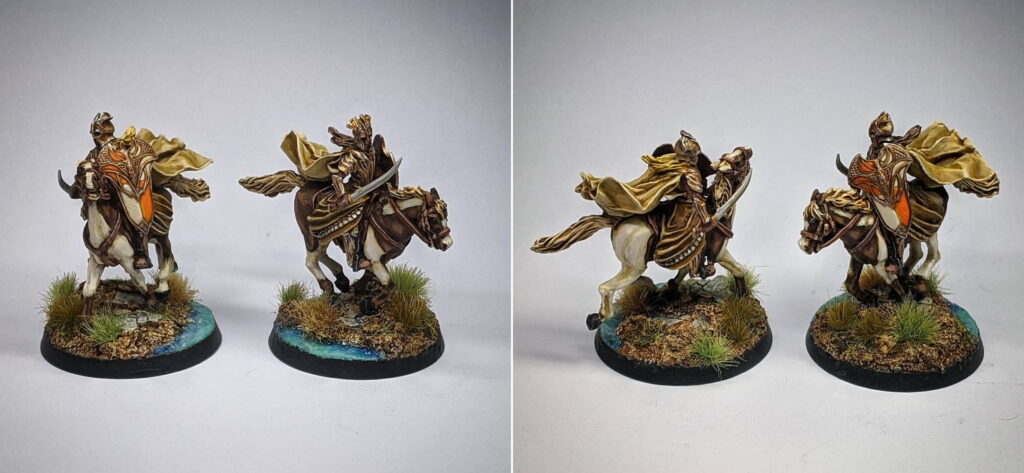
The last miniatures for the army (that are not dismounts) are a pair of Mirkwood Cavalry. I like these guys as – despite the lack of a lance like their Rivendell counterparts have – they make a great bodyguard for Thranduil on his Elk. Not only do they receive a buff in the presence of their king as Palace Guard do, but they can also keep pace with him should I find myself in a situation where I absolutely have to send Thranduil on ahead ahead.
Build wise, these were alright, although perhaps a little closer to the ‘acceptable, but not great’ end of the casting quality spectrum of Finecast than I would’ve liked. There were a couple of awkward gaps on the horses, and their swords were a complete mess – all bent out of shape, and so flimsy I managed to snap the pair of them while trying to straighten them out with hot water. To counteract this, I gave them each sword hands from a couple of spare plastic Palace Guard – this mostly worked, though I think the plastic hands are a little on the large size for these Finecast minis. Despite having the option on their profile, these miniatures didn’t come with optional shields either – although thankfully I still had a couple going spare in the Palace Guard box.
Much to my relief, the painting process went a lot smoother than the build did. The riders themselves were – despite a couple aesthetic differences – ultimately no different than the Palace Guard I’d painted before, leaving only the horses to figure out. Having already done white steeds for my Rivendell Knights and dark, ominous brown for my mounted Nazgul4, I wanted to do something a little different this time – maybe something a little special, given there was only two of them to do. After a little deliberation, I decided to paint them as Pinto horses.
I had it in my head that this would be more difficult to paint than a single toned horse, but the reality was that it isn’t all that different. The first step was blocking in the basic shapes of the colours, first rather roughly with the Elfic Flesh and a little more careful to get a good curved/blobby line with Dark Fleshtone. Beyond that, it was mostly the same as painting any other horse – with the exception that you could only really all over wash with the shade for the lighter colour, which in this case was Seraphim Sepia. After that had dried, I went in with some Agrax Earthshade to some choice spots on the brown tone to ensure there was an even amount of contrast on both the white and the brown. With the shading done, it was just the usual affair of layering and highlighting, using Dark Fleshtone to re-layer, Model Color Saddle Brown for chunky highlights and mixing in some Leather Brown to lighten things up a little for the brown highlights – and Elfic Flesh/White for the white areas.
I don’t know what possessed me to make the harness and reins the same Dark Fleshtone brown as the horse itself (instead of something more noticeably different like black), but I think they turned out alright despite some initial worries that they wouldn’t be visually distinctive enough over the brown fur. Nothing special about how I painted those – Dark Fleshtone, highlighted with a Dark Fleshtone/Elfic Flesh mix and washed down with a bit of Reikland Fleshshade. This created a somewhat brighter and warmer brown than the more de-saturated midtone created by the inclusion of Saddle Brown and Seraphim Sepia over the horses coat, and separated nicely the dark Agrax recess shading and sharp highlights on the reins.
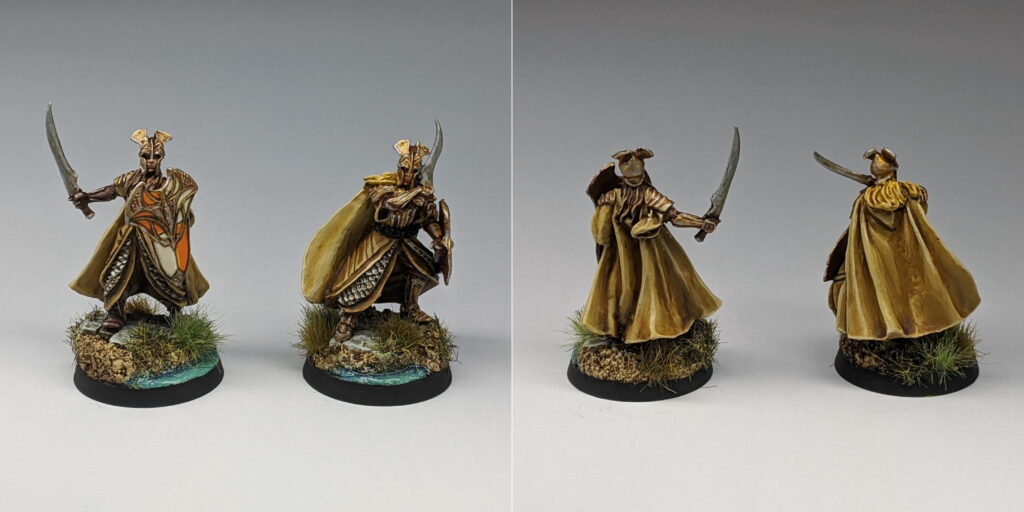
And that about does it for the unique miniatures in the army. Also pictured above and below are a couple of Mirkwood Armoured Elves and a Thranduil on foot for my dismounts. I don’t have an awful lot to say about these miniatures that I haven’t said on their mounted counterparts, except that it’s kind of interesting having a ForgeWorld model for your mounted hero with a separate Finecast dismount – both are detailed resin miniatures, but you can absolutely see where the former has beautifully cast, smooth features while the later is perhaps a little angular and rough around the edges. If you take a close look at the dismounted Thranduil’s swords, you’ll notice they’re significantly flimsier than the ForgeWorld models beefier, higher fidelity sculpt. I don’t think it’s fair to say that ForgeWorld is always a guarantee of superior quality, but in this case it absolutely is.
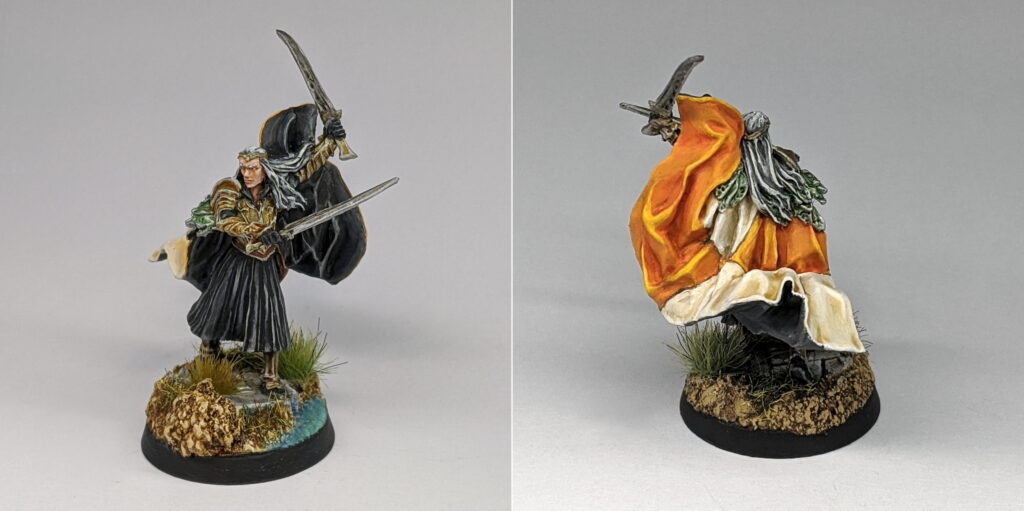
So, that’s my little Mirkwood allied contingent that – mixed with some of my Iron Hills – will make up my Forces of Good list for the next Scouring of Stirlingshire. Combine it with some of my Azog’s Legion and you get what I’m calling The Battle of Three Armies.
There’s still a lot of scope to expand both my Mirkwood and my Iron Hills up to 800pts armies in their own right though. I’ve still got another 18 Mirkwood Rangers left over from the Barrels out of Bond diorama, which would make a fun little detachment to run alongside the King and his Palace Guard. Likewise for Iron Hills, I’ve a few Crossbowmen sitting in a drawer waiting for a coat of paint – and I’ve been eyeing up a certain chariot for some time now. And of course there’s Eagles, Beorn and Lake Town…
That said, I’m going to draw a line under all of this for now. I feel like it’s time for a of pace5, but as ever, we’ll have to wait and see.
Until next time, thanks for reading and happy wargaming!

1 Well, maybe not this year. Scouring 2020 is as of yet unannounced and even if it did go ahead, it certainly couldn’t be 60 player affair it was in 2019.
2 Particularly given the glazed green scale mail on Thranduil below.
3 I wholeheartedly recommend picking up a set of Microbox drill bits for your pin vice if you haven’t already. They’re absurdly inexpensive at £6ish for a 20 piece set, and they go down to way smaller sizes than you’d normally get bundled with your hand drill – handy for fine pinning jobs and drilling smaller gun barrels alike. It also helps that they come in a handy storage box that helps keep them organised by size too. It’s a nice little upgrade for your pin vice, and something I’d always wanted but never really bothered looking for until recently – maybe I’ll add it to my list of helpful hobby tools that make my life better sometime.
4 Which, bizarrely, it looks like I managed to completely miss out in my Preparing the Narrative Campaign blog series. Although to be fair, those miniatures took might have taken longer to hunt down (particularly the Witch King unique pose) than they took to build and paint. Maybe I’ll do an addendum blog post on them to fill a slow hobby month in the future.
5 I’m trying to think if I’ve painted anything this year so far that isn’t Middle-earth, Blackstone Fortress or a terrain project…
